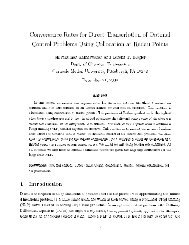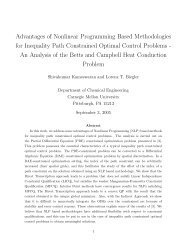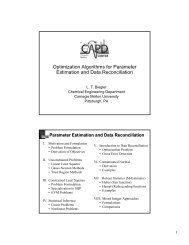MPEC Problem Formulations in Chemical Engineering Applications
MPEC Problem Formulations in Chemical Engineering Applications
MPEC Problem Formulations in Chemical Engineering Applications
Create successful ePaper yourself
Turn your PDF publications into a flip-book with our unique Google optimized e-Paper software.
7 ConclusionsWith the development and widespread use of large-scale nonl<strong>in</strong>ear programm<strong>in</strong>gtools for process optimization, there has been an associated applicationof complementarity formulations to represent discrete decisions. This study <strong>in</strong>vestigatesboth the formulation and solution strategies for the MathematicalPrograms with Compementarity Constra<strong>in</strong>ts (MPCCs). Because MPCCs havedependent consta<strong>in</strong>ts at all feasible po<strong>in</strong>ts along with unbounded multipliers,special care is needed <strong>in</strong> the formulation of associated optimization problemsalong with a reliable solution algorithm. In this study, we <strong>in</strong>vestigate and summarizea number of regularization and penalty MPCC formulations and f<strong>in</strong>dthat the penalty formulation is particularly advantageous, especially when coupledwith an active set NLP solver. This conclusion is observed <strong>in</strong> a numericalcomparison with a library of MPCC test problems.Because all MPCCs can be formulated as underly<strong>in</strong>g <strong>MPEC</strong> problems thatresult from nested optimization formulations, a necessary condition for wellbehavedMPCCs is that the <strong>in</strong>ner optimization problem be convex with solutionsthat are not restricted by upper level constra<strong>in</strong>ts. This condition is used to motivatea systematic strategy for the formulation of complementarity constra<strong>in</strong>ts.This strategy is applied to a number of widely-used examples <strong>in</strong> process eng<strong>in</strong>eer<strong>in</strong>g,<strong>in</strong>clud<strong>in</strong>g flow reversals, relief valves, compressor kickbacks, controllersaturation and disappearance of phases <strong>in</strong> equilibrium stages.This comb<strong>in</strong>ation of well-posed formulations and MPCC solutions strategiesis demonstrated on two large-scale case studies with as many as 8000 discretedecisions. First, <strong>in</strong> the discretized dynamic system with switches, both thepenalty and relaxed formulations are very effective with active set and barriersolvers, respectively. Second, <strong>in</strong> deal<strong>in</strong>g with disappear<strong>in</strong>g phases <strong>in</strong> distillationoptimization models, the penalty formulation shows significant performance improvementsover the NCP formulation <strong>in</strong> a previous study. From these results,we f<strong>in</strong>d that well-posed complementarities coupled with NLP problems basedon penalty formulations are efficient and effective strategies for the solution ofMPCCs <strong>in</strong> process eng<strong>in</strong>eer<strong>in</strong>g.AcknowledgementsFund<strong>in</strong>g from the National Science Foundation under grant #CTS-0438279 isgratefully appreciated. The authors also wish to thank Dr. Steven Dirkse forfruitful discussions and help with the NLPEC package.References[1] Anitescu, M., P. Tseng, and S.J. Wright, “Elastic-mode algorithms formathematical programs with equilibrium constra<strong>in</strong>ts: global convergenceand stationarity properties,” Math. Program., 110, pp. 337-371 (2007).26






